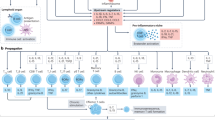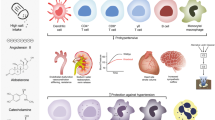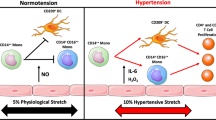Abstract
Purpose of Review
To summarize key advances in our understanding of the role of interleukin 17A (IL-17A) in the pathogenesis of hypertension and highlight important areas for future research and clinical translation.
Recent Findings
While T helper 17 (Th17) cells are major producers of IL-17A, there are several additional innate and adaptive immune cell sources including gamma-delta T cells, innate lymphoid cells, and natural killer cells. IL-17A promotes an increase in blood pressure through multiple mechanisms including inhibiting endothelial nitric oxide production, increasing reactive oxygen species formation, promoting vascular fibrosis, and enhancing renal sodium retention and glomerular injury. IL-17A production from Th17 cells is increased by high salt conditions in vitro and in vivo. There is also emerging data linking salt, the gut microbiome, and intestinal T cell IL-17A production. Novel therapeutics targeting IL-17A signaling are approved for the treatment of autoimmune diseases and show promise in both animal models of hypertension and human studies.
Summary
Hypertensive stimuli enhance IL-17A production. IL-17A is a key mediator of renal and vascular dysfunction in hypertensive mouse models and correlates with hypertension in humans. Large randomized clinical trials are needed to determine whether targeting IL-17A might be an effective adjunct treatment for hypertension and its associated end-organ dysfunction.

Similar content being viewed by others
References
Papers of particular interest, published recently, have been highlighted as: • Of importance •• Of major importance
Collaborators GBDRF. Global, regional, and national comparative risk assessment of 79 behavioural, environmental and occupational, and metabolic risks or clusters of risks, 1990-2015: a systematic analysis for the Global Burden of Disease Study 2015. Lancet. 2016;388(10053):1659–724. https://doi.org/10.1016/S0140-6736(16)31679-8.
Whelton PK, Carey RM, Aronow WS, Casey DE Jr, Collins KJ, Dennison Himmelfarb C, et al. 2017 ACC/AHA/AAPA/ABC/ACPM/AGS/APhA/ASH/ASPC/NMA/PCNA Guideline for the prevention, detection, evaluation, and management of high blood pressure in adults: Executive Summary: a report of the American College of Cardiology/American Heart Association Task Force on Clinical Practice Guidelines. Hypertension. 2018;71(6):1269–324. https://doi.org/10.1161/HYP.0000000000000066.
• Foti K, Wang D, Appel LJ, Selvin E. Hypertension awareness, treatment, and control in US adults: trends in the hypertension control cascade by population subgroup (National Health and Nutrition Examination Survey, 1999-2016). Am J Epidemiol. 2019;188(12):2165–74. https://doi.org/10.1093/aje/kwz177Comprehensive summary of trends in hypertension awareness, treatment, and control increased from 1999-2016, with few changes after 2010. However, disparities in hypertension control are apparent between age, sex, race/ethnicity.
Fryar CD, Ostchega Y, Hales CM, Zhang G, Kruszon-Moran D. Hypertension prevalence and control among adults: United States, 2015-2016. NCHS Data Brief. 2017;(289):1–8.
Elijovich F, Laffer CL, Sahinoz M, Pitzer A, Ferguson JF, Kirabo A. The gut microbiome, inflammation, and salt-sensitive hypertension. Curr Hypertens Rep. 2020;22(10):79. https://doi.org/10.1007/s11906-020-01091-9.
Patrick DM, Van Beusecum JP, Kirabo A. The role of inflammation in hypertension: novel concepts. Curr Opin Physiol. 2021;19:92–8. https://doi.org/10.1016/j.cophys.2020.09.016.
Madhur MS, Lob HE, McCann LA, Iwakura Y, Blinder Y, Guzik TJ, et al. Interleukin 17 promotes angiotensin II-induced hypertension and vascular dysfunction. Hypertension. 2010;55(2):500–7. doi: HYPERTENSIONAHA.109.145094. https://doi.org/10.1161/HYPERTENSIONAHA.109.145094.
Norlander AE, Saleh MA, Kamat NV, Ko B, Gnecco J, Zhu L, et al. Interleukin-17A Regulates renal sodium transporters and renal injury in angiotensin II-induced hypertension. Hypertension. 2016;68(1):167–74. https://doi.org/10.1161/HYPERTENSIONAHA.116.07493.
Caillon A, Mian MOR, Fraulob-Aquino JC, Huo KG, Barhoumi T, Ouerd S, et al. gammadelta T cells mediate angiotensin II-induced hypertension and vascular injury. Circulation. 2017;135(22):2155–62. https://doi.org/10.1161/CIRCULATIONAHA.116.027058.
Rouvier E, Luciani MF, Mattei MG, Denizot F, Golstein P. CTLA-8, cloned from an activated T cell, bearing AU-rich messenger RNA instability sequences, and homologous to a herpesvirus saimiri gene. J Immunol. 1993;150(12):5445–56.
Iwakura Y, Ishigame H, Saijo S, Nakae S. Functional specialization of interleukin-17 family members. Immunity. 2011;34(2):149–62. https://doi.org/10.1016/j.immuni.2011.02.012.
Tesmer LA, Lundy SK, Sarkar S, Fox DA. Th17 cells in human disease. Immunol Rev. 2008;223:87–113. doi: IMR628 [pii]. https://doi.org/10.1111/j.1600-065X.2008.00628.x.
** W, Dong C. IL-17 cytokines in immunity and inflammation. Emerg Microbes Infect. 2013;2(9):e60. https://doi.org/10.1038/emi.2013.58.
Wei L, Laurence A, Elias KM, O’Shea JJ. IL-21 is produced by Th17 cells and drives IL-17 production in a STAT3-dependent manner. J Biol Chem. 2007;282(48):34605–10. https://doi.org/10.1074/jbc.M705100200.
Huber M, Heink S, Pagenstecher A, Reinhard K, Ritter J, Visekruna A, et al. IL-17A secretion by CD8+ T cells supports Th17-mediated autoimmune encephalomyelitis. J Clin Invest. 2013;123(1):247–60. https://doi.org/10.1172/JCI63681.
Saleh MA, Norlander AE, Madhur MS. Inhibition of interleukin-17A, but not interleukin-17F, signaling lowers blood pressure, and reduces end-organ inflammation in angiotensin II–induced hypertension. JACC: Basic Transl Sci. 2016;1(7):606–16.
• Khairallah C, Chu TH, Sheridan BS. Tissue adaptations of memory and tissue-resident gamma delta T cells. Front Immunol. 2018;9:2636. https://doi.org/10.3389/fimmu.2018.02636Review on gamma-delta T cells and their integral role in maintaining epithelial and mucosal barrier integrity, tissue homeostatis, and pathogen control. In certain disease states, these cells can contribute to inflammation and disease progression.
Akitsu A, Iwakura Y. Interleukin-17-producing gammadelta T (gammadelta17) cells in inflammatory diseases. Immunology. 2018;155(4):418–26. https://doi.org/10.1111/imm.12993.
•• Higaki A, Mahmoud AUM, Paradis P, Schiffrin EL. Role of interleukin-23/interleukin-17 axis in T-cell mediated actions in hypertension. Cardiovasc Res. 2020. https://doi.org/10.1093/cvr/cvaa257A thorough review on the IL-23/IL-17 axis in hypertension. The IL-23/IL-17 axis may offer promising therepeutics in the treatment of hypertension.
Dale BL, Pandey AK, Chen Y, Smart CD, Laroumanie F, Ao M, et al. Critical role of Interleukin 21 and T follicular helper cells in hypertension and vascular dysfunction. JCI Insight. 2019;5:e129278. https://doi.org/10.1172/jci.insight.129278.
Gladiator A, LeibundGut-Landmann S. Innate lymphoid cells: new players in IL-17-mediated antifungal immunity. PLoS Pathog. 2013;9(12):e1003763. https://doi.org/10.1371/journal.ppat.1003763.
Nguyen H, Chiasson VL, Chatterjee P, Kopriva SE, Young KJ, Mitchell BM. Interleukin-17 causes Rho-kinase-mediated endothelial dysfunction and hypertension. Cardiovasc Res. 2013;97(4):696–704. https://doi.org/10.1093/cvr/cvs422.
Wu J, Thabet SR, Kirabo A, Trott DW, Saleh MA, **ao L, et al. Inflammation and mechanical stretch promote aortic stiffening in hypertension through activation of p38 mitogen-activated protein kinase. Circ Res. 2014;114(4):616–25. https://doi.org/10.1161/CIRCRESAHA.114.302157.
• Orejudo M, Garcia-Redondo AB, Rodrigues-Diez RR, Rodrigues-Diez R, Santos-Sanchez L, Tejera-Munoz A, et al. Interleukin-17A induces vascular remodeling of small arteries and blood pressure elevation. Clin Sci (Lond). 2020;134(5):513–27. https://doi.org/10.1042/CS20190682These studies demonstrate that IL-17A contributes to increased blood pressure through the remodeling of small mesenteric arteries and increased arterial stiffness.
Schuler R, Efentakis P, Wild J, Lagrange J, Garlapati V, Molitor M, et al. T Cell-derived IL-17A induces vascular dysfunction via perivascular fibrosis formation and dysregulation of (.)NO/cGMP signaling. Oxidative Med Cell Longev. 2019;2019:6721531. https://doi.org/10.1155/2019/6721531.
Xu L, Ding W, Stohl LL, Zhou XK, Azizi S, Chuang E, et al. Regulation of T helper cell responses during antigen presentation by norepinephrine-exposed endothelial cells. Immunology. 2018;154(1):104–21. https://doi.org/10.1111/imm.12871.
Loperena R, Van Beusecum JP, Itani HA, Engel N, Laroumanie F, **ao L, et al. Hypertension and increased endothelial mechanical stretch promote monocyte differentiation and activation: roles of STAT3, interleukin 6 and hydrogen peroxide. Cardiovasc Res. 2018. https://doi.org/10.1093/cvr/cvy112.
Chiasson VL, Pakanati AR, Hernandez M, Young KJ, Bounds KR, Mitchell BM. Regulatory T-cell augmentation or interleukin-17 inhibition prevents calcineurin inhibitor-induced hypertension in mice. Hypertension. 2017;70(1):183–91. https://doi.org/10.1161/HYPERTENSIONAHA.117.09374.
Orejudo M, Rodrigues-Diez RR, Rodrigues-Diez R, Garcia-Redondo A, Santos-Sanchez L, Randez-Garbayo J, et al. Interleukin 17A Participates in renal inflammation associated to experimental and human hypertension. Front Pharmacol. 2019;10:1015. https://doi.org/10.3389/fphar.2019.01015.
Rudemiller NP, Patel MB, Zhang JD, Jeffs AD, Karlovich NS, Griffiths R, et al. C-C Motif chemokine 5 attenuates angiotensin II-dependent kidney injury by limiting renal macrophage infiltration. Am J Pathol. 2016;186(11):2846–56. https://doi.org/10.1016/j.ajpath.2016.07.015.
Alsheikh AJ, Dasinger JH, Abais-Battad JM, Fehrenbach DJ, Yang C, Cowley AW Jr, et al. CCL2 mediates early renal leukocyte infiltration during salt-sensitive hypertension. Am J Physiol Ren Physiol. 2020;318(4):F982–F93. https://doi.org/10.1152/ajprenal.00521.2019.
Marko L, Kvakan H, Park JK, Qadri F, Spallek B, Binger KJ, et al. Interferon-gamma signaling inhibition ameliorates angiotensin II-induced cardiac damage. Hypertension. 2012;60(6):1430–6. https://doi.org/10.1161/HYPERTENSIONAHA.112.199265.
Krebs CF, Lange S, Niemann G, Rosendahl A, Lehners A, Meyer-Schwesinger C, et al. Deficiency of the interleukin 17/23 axis accelerates renal injury in mice with deoxycorticosterone acetate+angiotensin ii-induced hypertension. Hypertension. 2014;63(3):565–71. https://doi.org/10.1161/HYPERTENSIONAHA.113.02620.
Kamat NV, Thabet SR, **ao L, Saleh MA, Kirabo A, Madhur MS, et al. Renal transporter activation during angiotensin-II hypertension is blunted in interferon-gamma-/- and interleukin-17A-/- mice. Hypertension. 2015;65(3):569–76. https://doi.org/10.1161/HYPERTENSIONAHA.114.04975.
Ellison DH. Ubiquitylation and the pathogenesis of hypertension. J Clin Invest. 2013;123(2):546–8. https://doi.org/10.1172/JCI66882.
•• Norlander AE, Madhur MS. Inflammatory cytokines regulate renal sodium transporters: how, where, and why? Am J Physiol Ren Physiol. 2017. https://doi.org/10.1152/ajprenal.00465.2016This review summarizes how inflammatory cytokines regulate sodium transporters along the nephron.
Elliott P, Dyer A, Stamler R. The INTERSALT study: results for 24 hour sodium and potassium, by age and sex. INTERSALT Co-operative Research Group. J Hum Hypertens. 1989;3(5):323–30.
Kleinewietfeld M, Manzel A, Titze J, Kvakan H, Yosef N, Linker RA, et al. Sodium chloride drives autoimmune disease by the induction of pathogenic TH17 cells. Nature. 2013;496(7446):518–22. https://doi.org/10.1038/nature11868.
Wu C, Yosef N, Thalhamer T, Zhu C, **ao S, Kishi Y, et al. Induction of pathogenic TH17 cells by inducible salt-sensing kinase SGK1. Nature. 2013;496(7446):513–7. https://doi.org/10.1038/nature11984.
•• Norlander AE, Saleh MA, Pandey AK, Itani HA, Wu J, **ao L, et al. A salt-sensing kinase in T lymphocytes, SGK1, drives hypertension and hypertensive end-organ damage. JCI Insight. 2017;2(13). https://doi.org/10.1172/jci.insight.92801This paper demonstrates a mechanism by which T cells sense salt and describes how deletion of the salt-sensing kinase SGK1 in T cells provides significant protection from hypertenive end-organ damage.
• Van Beusecum JP, Barbaro NR, McDowell Z, Aden LA, **ao L, Pandey AK, et al. High salt activates CD11c(+) antigen-presenting cells via SGK (serum glucocorticoid kinase) 1 to promote renal inflammation and salt-sensitive hypertension. Hypertension. 2019;74(3):555–63. https://doi.org/10.1161/HYPERTENSIONAHA.119.12761This paper describes a salt sensing mechanism in dendritic cells and how dendritic cells contribute to the development of hypertension.
•• Yang YH, Istomine R, Alvarez F, Al-Aubodah TA, Shi XQ, Takano T, et al. Salt Sensing by serum/glucocorticoid-regulated kinase 1 promotes Th17-like inflammatory adaptation of Foxp3(+) regulatory T cells. Cell Rep. 2020;30(5):1515–29 e4. https://doi.org/10.1016/j.celrep.2020.01.002In an SGK1-dependent manner, high salt drives Treg cells to adapt a Th17-like cell phenotype. This paper highlights the plasticity of T cells and the role of salt in inflammation.
Matthias J, Heink S, Picard F, Zeitrag J, Kolz A, Chao YY, et al. Salt generates antiinflammatory Th17 cells but amplifies pathogenicity in proinflammatory cytokine microenvironments. J Clin Invest. 2020;130(9):4587–600. https://doi.org/10.1172/JCI137786.
Kopp C, Linz P, Dahlmann A, Hammon M, Jantsch J, Muller DN, et al. 23Na magnetic resonance imaging-determined tissue sodium in healthy subjects and hypertensive patients. Hypertension. 2013;61(3):635–40. https://doi.org/10.1161/HYPERTENSIONAHA.111.00566.
Machnik A, Neuhofer W, Jantsch J, Dahlmann A, Tammela T, Machura K, et al. Macrophages regulate salt-dependent volume and blood pressure by a vascular endothelial growth factor-C-dependent buffering mechanism. Nat Med. 2009;15(5):545–52. https://doi.org/10.1038/nm.1960.
Rossitto G, Mary S, Chen JY, Boder P, Chew KS, Neves KB, et al. Tissue sodium excess is not hypertonic and reflects extracellular volume expansion. Nat Commun. 2020;11(1):4222. https://doi.org/10.1038/s41467-020-17820-2.
Douzandeh-Mobarrez B, Kariminik A. Gut Microbiota and IL-17A: physiological and Pathological Responses. Probiotics Antimicrob Proteins. 2019;11(1):1–10. https://doi.org/10.1007/s12602-017-9329-z.
Abusleme L, Moutsopoulos NM. IL-17: overview and role in oral immunity and microbiome. Oral Dis. 2017;23(7):854–65. https://doi.org/10.1111/odi.12598.
Hooper LV, Littman DR, Macpherson AJ. Interactions between the microbiota and the immune system. Science. 2012;336(6086):1268–73. https://doi.org/10.1126/science.1223490.
Chu F, Shi M, Lang Y, Shen D, ** T, Zhu J, et al. Gut microbiota in multiple sclerosis and experimental autoimmune encephalomyelitis: current applications and future perspectives. Mediat Inflamm. 2018;2018:8168717. https://doi.org/10.1155/2018/8168717.
Zhang X, Zhang D, Jia H, Feng Q, Wang D, Liang D, et al. The oral and gut microbiomes are perturbed in rheumatoid arthritis and partly normalized after treatment. Nat Med. 2015;21(8):895–905. https://doi.org/10.1038/nm.3914.
Sun Y, Chen Q, Lin P, Xu R, He D, Ji W, et al. Characteristics of gut microbiota in patients with rheumatoid arthritis in Shanghai, China. Front Cell Infect Microbiol. 2019;9:369. https://doi.org/10.3389/fcimb.2019.00369.
• Kim S, Goel R, Kumar A, Qi Y, Lobaton G, Hosaka K, et al. Imbalance of gut microbiome and intestinal epithelial barrier dysfunction in patients with high blood pressure. Clin Sci (Lond). 2018;132(6):701–18. https://doi.org/10.1042/CS20180087This manuscript highlights the association of intestinal barrier and microbiome dysfunction in human hypertension. Targeting the gut microbiome may serve as a potential therapeutic avenue to treat hypertension.
Li J, Zhao F, Wang Y, Chen J, Tao J, Tian G, et al. Gut microbiota dysbiosis contributes to the development of hypertension. Microbiome. 2017;5(1):14. https://doi.org/10.1186/s40168-016-0222-x.
Yan Q, Gu Y, Li X, Yang W, Jia L, Chen C, et al. Alterations of the gut microbiome in hypertension. Front Cell Infect Microbiol. 2017;7:381. https://doi.org/10.3389/fcimb.2017.00381.
Dan X, Mushi Z, Baili W, Han L, Enqi W, Huanhu Z, et al. Differential analysis of hypertension-associated intestinal microbiota. Int J Med Sci. 2019;16(6):872–81. https://doi.org/10.7150/ijms.29322.
Karbach SH, Schonfelder T, Brandao I, Wilms E, Hormann N, Jackel S, et al. Gut microbiota promote angiotensin II-induced arterial hypertension and vascular dysfunction. J Am Heart Assoc. 2016;5(9). https://doi.org/10.1161/JAHA.116.003698.
Jama HA, Kaye DM, Marques FZ. The gut microbiota and blood pressure in experimental models. Curr Opin Nephrol Hypertens. 2019;28(2):97–104. https://doi.org/10.1097/MNH.0000000000000476.
Toral M, Robles-Vera I, de la Visitacion N, Romero M, Sanchez M, Gomez-Guzman M, et al. Role of the immune system in vascular function and blood pressure control induced by faecal microbiota transplantation in rats. Acta Physiol (Oxford). 2019;227(1):e13285. https://doi.org/10.1111/apha.13285.
Wilck N, Matus MG, Kearney SM, Olesen SW, Forslund K, Bartolomaeus H, et al. Salt-responsive gut commensal modulates TH17 axis and disease. Nature. 2017;551(7682):585–9. https://doi.org/10.1038/nature24628.
Itani HA, McMaster WG Jr, Saleh MA, Nazarewicz RR, Mikolajczyk TP, Kaszuba AM, et al. Activation of human T cells in hypertension: studies of humanized mice and hypertensive humans. Hypertension. 2016;68(1):123–32. https://doi.org/10.1161/HYPERTENSIONAHA.116.07237.
Yao W, Sun Y, Wang X, Niu K. Elevated serum level of interleukin 17 in a population with prehypertension. J Clin Hypertens (Greenwich). 2015;17(10):770–4. https://doi.org/10.1111/jch.12612.
Masenga SK, Elijovich F, Hamooya BM, Nzala S, Kwenda G, Heimburger DC, et al. Elevated eosinophils as a feature of inflammation associated with hypertension in virally suppressed people living with HIV. J Am Heart Assoc. 2020;9(4):e011450. https://doi.org/10.1161/JAHA.118.011450.
Wang Z, Shi W, Liang X, Wang W, Liang J. Association of interleukin 17 / angiotensin II with refractory hypertension risk in hemodialysis patients. Afr Health Sci. 2016;16(3):766–71. https://doi.org/10.4314/ahs.v16i3.17.
Ji Q, Cheng G, Ma N, Huang Y, Lin Y, Zhou Q, et al. Circulating Th1, Th2, and Th17 levels in hypertensive patients. Dis Markers. 2017;2017:7146290. https://doi.org/10.1155/2017/7146290.
•• von Stebut E, Reich K, Thaci D, Koenig W, Pinter A, Korber A, et al. Impact of Secukinumab on endothelial dysfunction and other cardiovascular disease parameters in psoriasis patients over 52 weeks. J Invest Dermatol. 2019;139(5):1054–62. https://doi.org/10.1016/j.jid.2018.10.042Secukinumab, a monoclonal antibody against IL-17A, has shown high efficacy in treatment against psoriasis. This randomized, double-blinded, placebo-controlled trial indicates secukinumab may also have beneficial effects on cardiovascular risk through its effect on flow mediated dilation.
Han L, Yang J, Wang X, Li D, Lv L, Li B. Th17 cells in autoimmune diseases. Front Med. 2015;9(1):10–9. https://doi.org/10.1007/s11684-015-0388-9.
Hueber W, Patel DD, Dryja T, Wright AM, Koroleva I, Bruin G, et al. Effects of AIN457, a fully human antibody to interleukin-17A, on psoriasis, rheumatoid arthritis, and uveitis. Sci Transl Med. 2010;2(52):52ra72. https://doi.org/10.1126/scitranslmed.3001107.
Papp KA, Langley RG, Sigurgeirsson B, Abe M, Baker DR, Konno P, et al. Efficacy and safety of secukinumab in the treatment of moderate-to-severe plaque psoriasis: a randomized, double-blind, placebo-controlled phase II dose-ranging study. Br J Dermatol. 2013;168(2):412–21. https://doi.org/10.1111/bjd.12110.
Elnabawi YA, Dey AK, Goyal A, Groenendyk JW, Chung JH, Belur AD, et al. Coronary artery plaque characteristics and treatment with biologic therapy in severe psoriasis: results from a prospective observational study. Cardiovasc Res. 2019;115(4):721–8. https://doi.org/10.1093/cvr/cvz009.
Author information
Authors and Affiliations
Corresponding author
Ethics declarations
Conflict of Interest
The authors declare no conflicts of interest relevant to this manuscript.
Human and Animal Rights and Informed Consent
This article does not contain any studies with human or animal subjects performed by any of the authors.
Additional information
Publisher’s Note
Springer Nature remains neutral with regard to jurisdictional claims in published maps and institutional affiliations.
This article is part of the Topical Collection on Inflammation and Cardiovascular Diseases
Rights and permissions
About this article
Cite this article
Davis, G.K., Fehrenbach, D.J. & Madhur, M.S. Interleukin 17A: Key Player in the Pathogenesis of Hypertension and a Potential Therapeutic Target. Curr Hypertens Rep 23, 13 (2021). https://doi.org/10.1007/s11906-021-01128-7
Accepted:
Published:
DOI: https://doi.org/10.1007/s11906-021-01128-7




